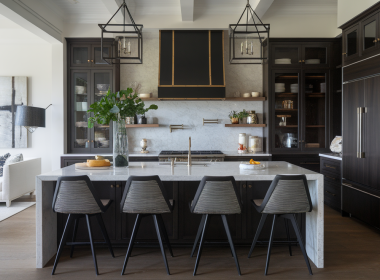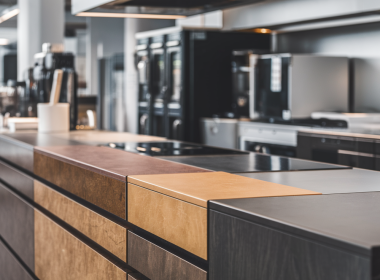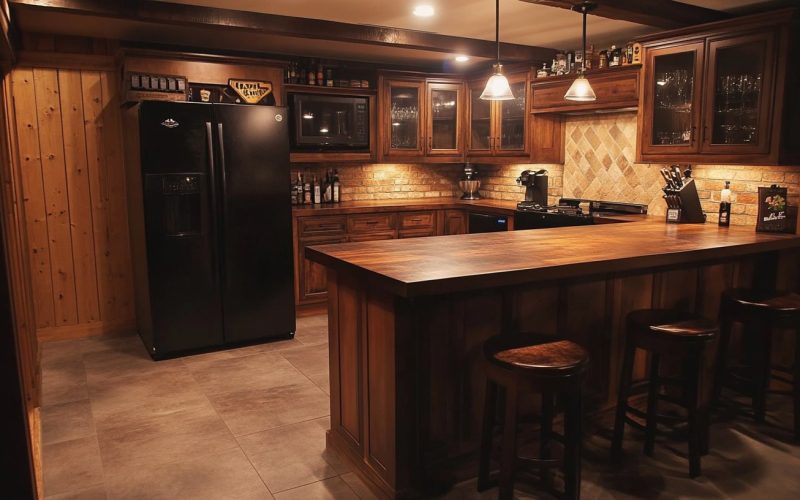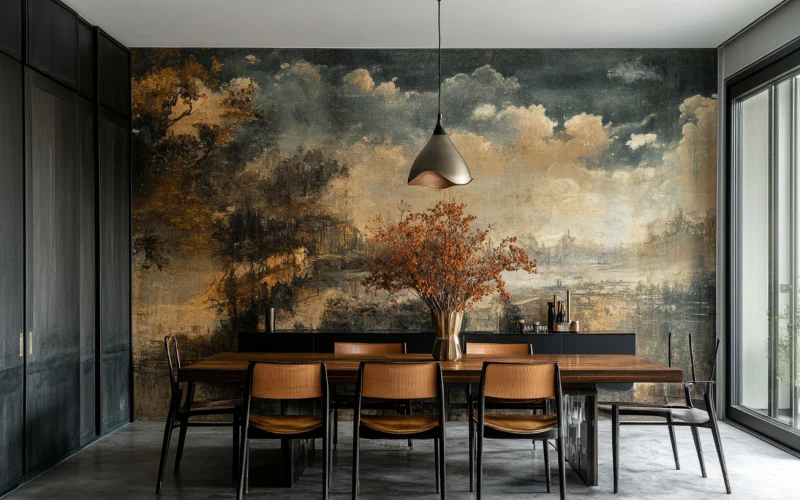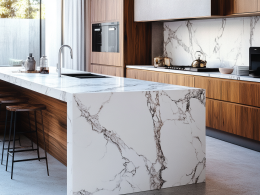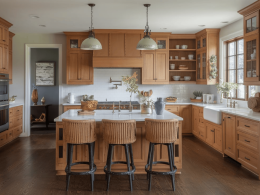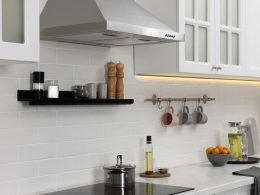As more Canadian homeowners explore ways to maximize their basement spaces, basement kitchens have become a popular choice for creating functional, stylish living areas. A well-designed basement kitchen can serve as a practical cooking space, a spot for entertaining, or even a separate living area.
The designers at EasyBasements have prepared top 5 trends in basement kitchen design, and offer insights on how to create a kitchen that’s both modern and efficient. Curious about finding out more? Let’s jump right in!
Trend 1: Open Concept Layout and Space Zoning
Open-concept layouts are gaining popularity as they help smaller basement kitchens feel larger and more integrated. However, it is essential to carefully define each space within this layout to maintain function without compromising flow.
An open concept makes the kitchen part of a larger living area, but clever zoning keeps each space distinct, which is especially useful in a basement setting.
Benefits
Enhanced Airflow and Light Distribution
An open-concept basement kitchen allows for better airflow and light spread, essential in basements where natural light is limited. Without walls, air circulates freely, keeping the kitchen fresh, while light reaches more areas, making the space feel brighter and more open. And this is very important!
Ideal for Entertaining
With a seamless flow between the kitchen and living or dining spaces, an open layout is perfect for hosting. Guests can gather comfortably around the kitchen, making it a functional, social space ideal for gatherings and family activities.
How to Implement
Choose Kitchen Islands and Breakfast Bars
Adding a kitchen island or breakfast bar helps create a boundary without using walls. It also adds counter space and storage, which is a great plus these days.
Opt for Flooring Differences
You can use different flooring materials in the kitchen and living areas to visually separate spaces. For example, using tiles in the kitchen and wood flooring in the adjacent space will definitely work.
Consider Accent Lighting
Position task lighting over kitchen work areas and softer ambient lighting in the living zone to establish distinct functional areas.
Trend 2: Use of Natural and Eco-friendly Materials
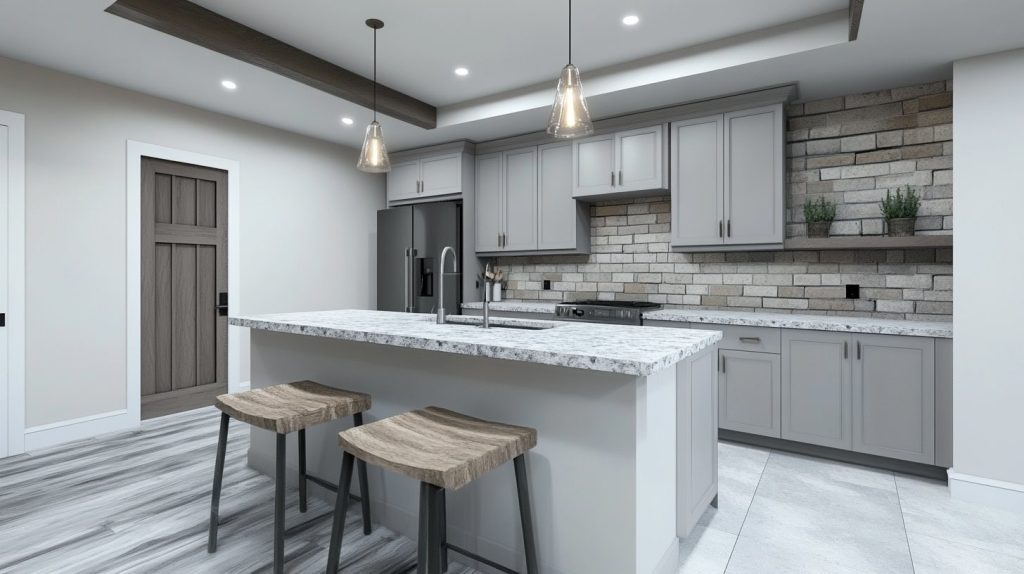
Nowadays, homeowners are increasingly choosing sustainable, eco-friendly materials for basement kitchens, favoring options that are beautiful and environmentally responsible at the same time. Using natural materials like reclaimed wood, bamboo, stone, and other finishes and furniture enhances the kitchen’s aesthetic and promotes a much healthier indoor environment.
Benefits
Healthier Indoor Air Quality
Eco-friendly materials such as low-VOC paints, certified wood, and natural stone contribute to a cleaner and healthier basement kitchen environment. These materials also help reduce allergens and improve air quality in enclosed spaces by minimizing harmful emissions.
Long-Lasting Durability and Timeless Aesthetics
Natural materials like stone countertops, reclaimed wood cabinets, and sustainable bamboo flooring are environmentally friendly and also highly durable. Their timeless appeal adds warmth and value to the kitchen, ensuring that the space remains attractive and functional for years to come.
How to Implement
Choose FSC-Certified Wood for Cabinets
Sustainably sourced, certified wood cabinetry aligns with green building standards and enhances the aesthetic appeal of basement kitchens.
Opt for Natural Stone Countertops
Countertops in granite, quartz, or recycled materials are not only eco-friendly but also add elegance, functionality, and lasting beauty.
Consider Recycled and Reclaimed Materials
Incorporate recycled glass or reclaimed wood for a unique look, contributing to an environmentally friendly design.
Trend 3: Integration of Smart Technologies
Integrating modern gadgets and automation systems in basement kitchens brings a new level of convenience and functionality. It is even essential now! With devices that can be controlled via smartphone or voice, smart kitchens allow you to manage cooking, lighting, and temperature remotely, making them ideal for basement spaces where efficiency is key.
Benefits
Increased Comfort and Convenience
Smart appliances and automation make it easy to control kitchen functions from anywhere. Imagine starting your oven or adjusting lighting without needing to be in the kitchen… Sounds perfect, especially for busy households.
Energy Efficiency and Enhanced Safety
Smart technology helps you optimize energy use and often includes built-in safety features like automatic shut-off timers, which is especially beneficial in basement kitchens where monitoring may be limited.
How to Implement
Install Smart Appliances Controllable via Smartphone
Look for Wi-Fi-enabled appliances, like smart ovens, fridges, and dishwashers. For instance, a smart fridge can track items and alert you when supplies run low, while a smart oven allows you to preheat remotely. These features make meal prep and inventory management effortless and are ideal for a functional basement kitchen.
Integrate Lighting and Climate Control Systems
You can use smart bulbs and a smart thermostat to easily adjust lighting and temperature. Smart lighting can be customized for task lighting during cooking or ambient lighting for a cozier setting, and it can even be set to different so-called “modes” or dimmed remotely. Smart climate control keeps the basement kitchen comfortable, especially in fluctuating basement temperatures.
Trend 4: Maximizing Natural Light
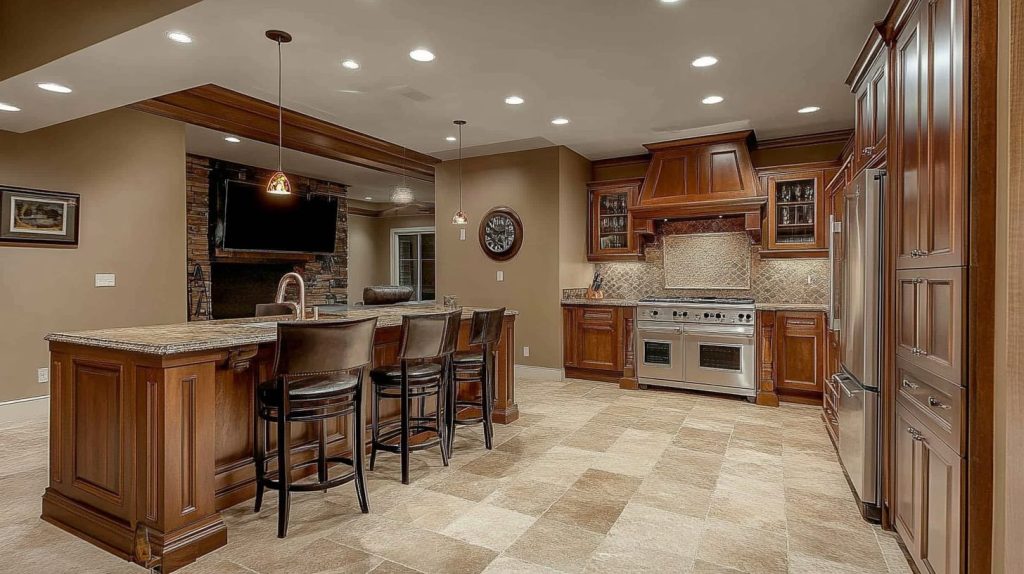
Since basements typically lack natural light, maximizing any available daylight is essential in basement kitchens.
A bright, well-lit kitchen space improves visibility and also makes the kitchen feel more inviting and less confined. This trend emphasizes using design elements that reflect and enhance light to create an open and airy ambiance.
Benefits
Improved Ambiance
A well-lit basement kitchen feels spacious and inviting. It helps to counteract the typical basement “closed-in” feeling. Natural light brings warmth and makes the kitchen feel like a natural extension of your home.
Lower Energy Costs
Increased daylight reduces the need for artificial lighting, which means lower energy bills. Using natural light more efficiently also supports eco-friendly living.
Enhanced Safety
More natural light improves visibility, and it reduces the risk of accidents while cooking or moving around the kitchen. For families with children or seniors, better lighting adds a valuable safety element.
How to Implement
Install Light Wells and Large Egress Windows
Light wells and egress windows bring in maximum sunlight while adding safety features. They’re ideal for boosting natural light and creating an inviting basement kitchen.
Use Reflective Surfaces and Light Colors
Opt for glossy countertops, glass tiles, and light-colored walls to bounce light around the room, making it feel open and bright.
Add Mirrors and Glass Elements
Mirrors and glass-front cabinets help reflect light, increasing brightness and visual depth, making the kitchen feel more spacious.
Consider Solar Tubes or LED Strips
Solar tubes provide natural light even without direct windows, and daylight-mimicking LED strips under cabinets keep the space bright and welcoming.
Trend 5: Personalization and Unique Design Solutions

Personalization has become a central trend in basement kitchen design. Why? Simple. It allows homeowners to create a space that feels uniquely theirs.
Integrating custom design elements, bold color choices, and interesting textures allows a basement kitchen to reflect individual taste while enhancing comfort and functionality. This trend emphasizes stepping away from standard solutions and instead crafting a basement kitchen that truly feels like part of the home.
Benefits
A Unique, Eye-Catching Space
Custom details like handmade tiles, unique lighting, or bold backsplashes make your basement kitchen stand out. Personalized touches add visual interest and create a memorable space that feels unique to you.
Enhanced Comfort and Connection
A basement kitchen that reflects your style becomes more inviting and comfortable. It makes it a perfect space for hosting guests or enjoying family meals. Personalized design fosters a cozy and connected atmosphere.
How to Implement
Include Handmade or Custom Decor
Handmade tiles, custom shelving, or artisanal light fixtures can add unique character to the kitchen. Consider using reclaimed wood or vintage hardware to further personalize the look.
Use Bold Colors and Textures
Don’t be afraid to experiment with color combinations or textured finishes. A rich accent wall, patterned backsplash, or textured cabinet finish adds depth and personality, making the entire space feel inviting and stylish.
Conclusion
Today’s basement kitchens are definitely much more than just secondary cooking spaces. They are multi-purpose areas that enhance the entire’s home’s functionality and aesthetic appeal. With trends focused on open layouts, sustainable materials, smart technology, optimized lighting, and personalization, a basement kitchen can become a highly valued part of any home.
Are you seeking a cozy, practical space? Or maybe you prefer a modern, tech-enabled kitchen, which is also trendy this year? It doesn’t matter! These trends offer a solid foundation for creating a basement kitchen that meets your lifestyle needs and taste.
The basement renovation contractors at EasyBasements are ready to help you do just that!
Get Started with Your Basement Kitchen Renovation!
Ready to transform your basement into a functional and stylish kitchen? Start planning today by considering these top trends, and consult with professional designers to help you make the most of your space. With the right approach, your basement kitchen can be a beautiful, versatile addition to your home.


